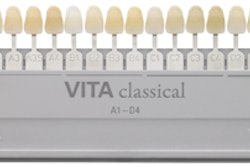Glidewell Laboratories has moved closer to producing transparent nanozirconia by successfully synthesizing 3-nm zirconia nanocrystals produced by "bottom-up" nanotechnology.
The research team, led by Ken Knapp, Glidewell Laboratories' program manager and lead researcher, developed a method for producing nonagglomerated 3-nm nanocrystalline zirconia powder using a revolutionary bottom-up nanotechnology technique known as gas-phase condensation.
The focused effort of the nanozirconia research team over the last year has resulted in new discoveries about the nature of sub-5-nm nanozirconia crystals, and Glidewell has filed a U.S. patent application on the new ceramic nanotechnology. This method consists of colliding high-energy yttrium, zirconium, and oxygen ions together in an energetic gaseous phase and condensing yttria zirconia nanocrystal particles resulting from atomic collisions during flight in the gas phase. The condensed yttria zirconia nanocrystal particles are separated from the gas phase and collected in the form of nanocrystalline powder.
"The key to making transparent polycrystalline zirconia material is starting with a nonagglomerated yttria zirconia primary crystal size less than 5 nm," Knapp said in a press release. "Glidewell's new gas-phase condensation nanotechnology for producing nanozirconia will allow us to overcome the fundamental polycrystalline birefringence barrier to manufacturing a transparent, high-strength monolithic dental ceramic product."
Conventional nanozirconia powder is typically produced by "top-down" nanotechnology methods such as hydrothermal synthesis. Many of the nanozirconia powders available on the market today are comprised of hard-agglomerated nanocrystals with a primary crystal size of about 30 nm, according to Glidewell. After sintering, typical nanozirconia grain size is between 500 nm and 1000 nm.
The top-down method is widely used to produce nanocrystalline materials by breaking down larger particles and agglomerates into smaller ones, typically by ball milling. The bottom-up nanotechnology method builds up nanoscale materials atom by atom or molecule by molecule. The bottom-up method has a lower scale limit on the atomic or molecular level. Additionally, the bottom-up-produced nanocrystalline structures are not altered during the process of forming the nanoscale crystals, whereas top-down methods alter the crystal structure and surface chemistry.
Common zirconia dental ceramics are translucent and not transparent as a result of light scattering during transmission by birefringence and porosity. Light scattering by birefringence is an intrinsic property of polycrystalline optical materials with an anisotropic crystalline index of refraction. Birefringence is reduced dramatically when the sintered grain size is reduced below 100 nm. Porosity causes light scattering in the visible spectrum between 400 nm and700 nm, which reduces the zirconia optical transparency.
The future for high-strength aesthetic nanozirconia is agglomerate-free sub-5-nm powder, noted James Glidewell, CDT, CEO, and president of Glidewell Laboratories.



















